Monetary Policy in the UK: MPC, Base Rate, and Economic Impact
VerifiedAdded on 2019/12/28
|7
|2107
|426
Report
AI Summary
This report provides a comprehensive overview of monetary policy, focusing on its application and impact within the United Kingdom. It begins by defining monetary policy and its significance, emphasizing the role of the central bank in managing the money supply to stabilize the economy. The report then delves into the functions of the Monetary Policy Committee (MPC) of the Bank of England, detailing its responsibility for setting interest rates and implementing monetary measures to maintain the inflation target of 2%. It examines the tools employed by the MPC, such as the bank rate, and how these tools influence consumer spending, asset prices, and exchange rates. Furthermore, the report explores the factors influencing the MPC's decisions, including fluctuations in the global market, stock market turbulence, slow economic growth, and fluctuating oil prices. The report also addresses policy conflicts that can arise, such as those between full employment and low inflation or economic growth and balance of payments. The conclusion suggests that the MPC is likely to maintain the current base rate due to these complex economic conditions.
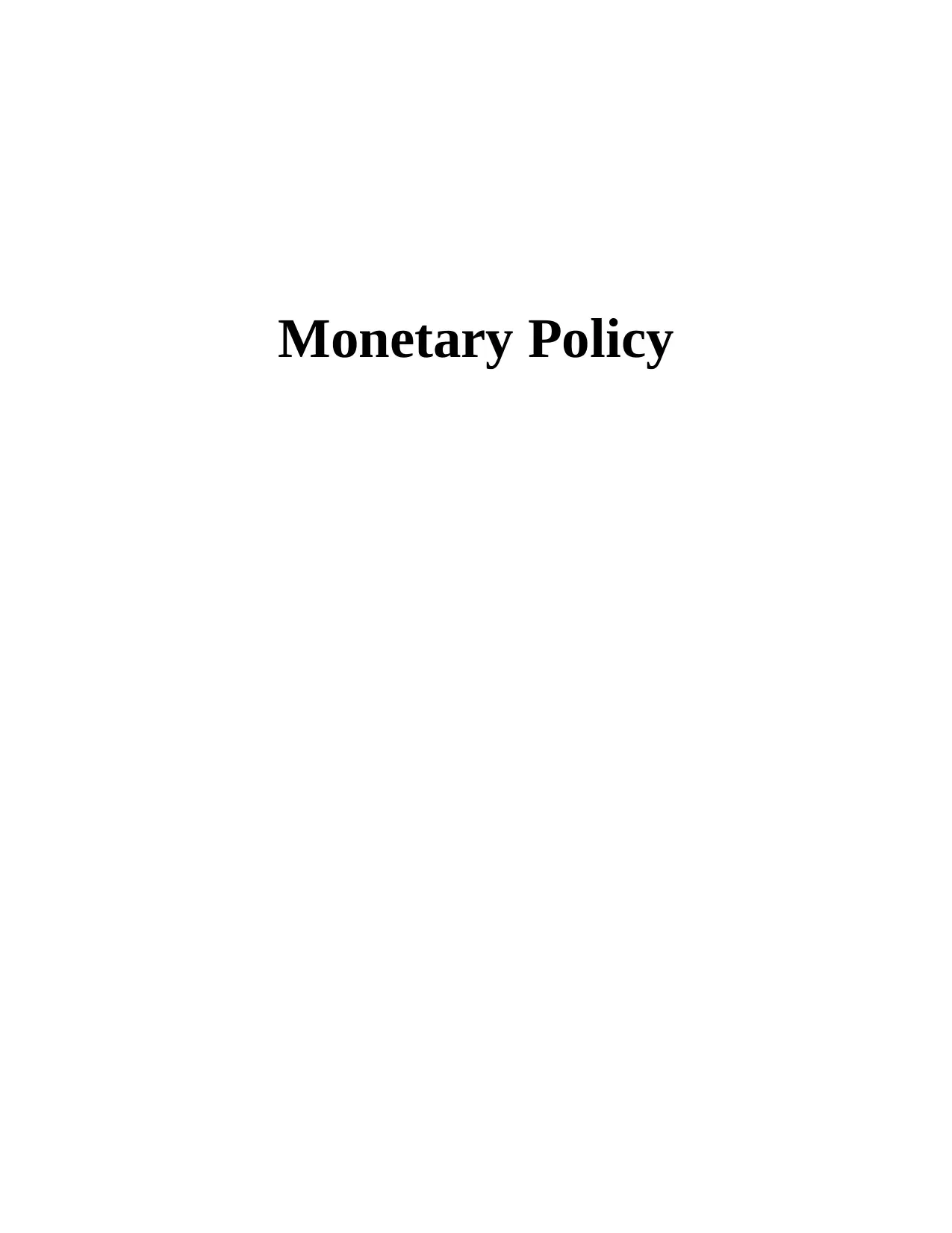
Monetary Policy
Paraphrase This Document
Need a fresh take? Get an instant paraphrase of this document with our AI Paraphraser
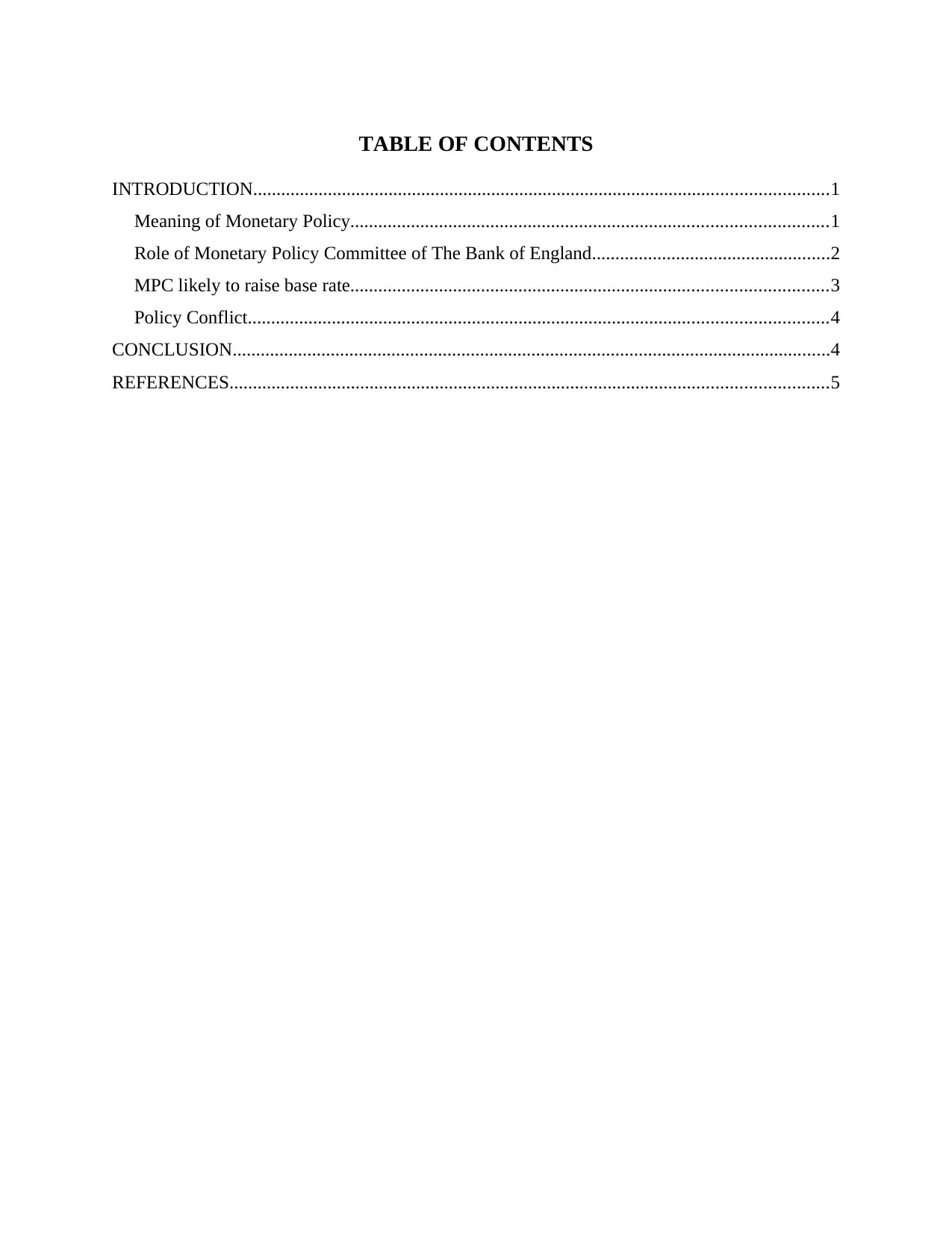
TABLE OF CONTENTS
INTRODUCTION...........................................................................................................................1
Meaning of Monetary Policy......................................................................................................1
Role of Monetary Policy Committee of The Bank of England...................................................2
MPC likely to raise base rate......................................................................................................3
Policy Conflict............................................................................................................................4
CONCLUSION................................................................................................................................4
REFERENCES................................................................................................................................5
INTRODUCTION...........................................................................................................................1
Meaning of Monetary Policy......................................................................................................1
Role of Monetary Policy Committee of The Bank of England...................................................2
MPC likely to raise base rate......................................................................................................3
Policy Conflict............................................................................................................................4
CONCLUSION................................................................................................................................4
REFERENCES................................................................................................................................5
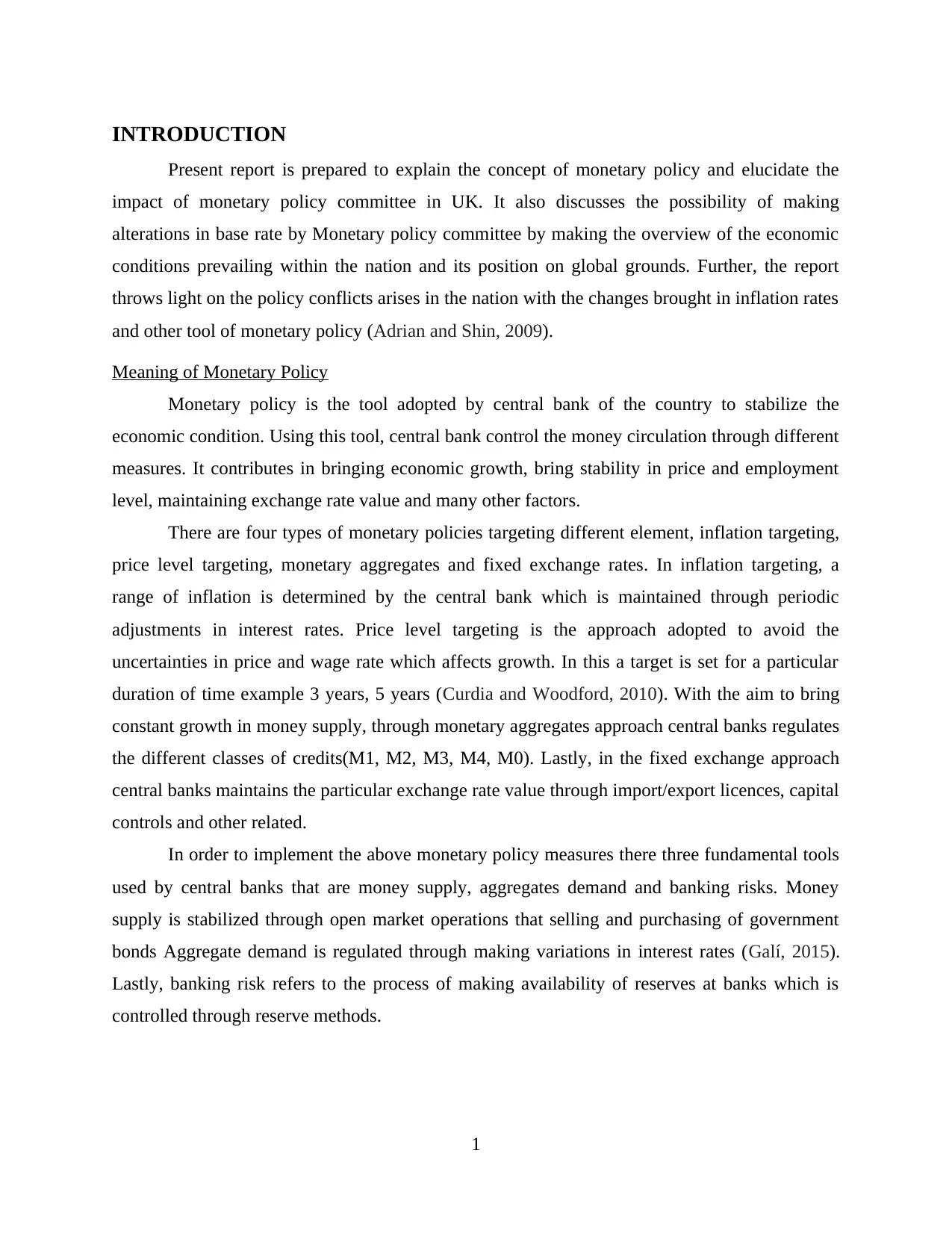
INTRODUCTION
Present report is prepared to explain the concept of monetary policy and elucidate the
impact of monetary policy committee in UK. It also discusses the possibility of making
alterations in base rate by Monetary policy committee by making the overview of the economic
conditions prevailing within the nation and its position on global grounds. Further, the report
throws light on the policy conflicts arises in the nation with the changes brought in inflation rates
and other tool of monetary policy (Adrian and Shin, 2009).
Meaning of Monetary Policy
Monetary policy is the tool adopted by central bank of the country to stabilize the
economic condition. Using this tool, central bank control the money circulation through different
measures. It contributes in bringing economic growth, bring stability in price and employment
level, maintaining exchange rate value and many other factors.
There are four types of monetary policies targeting different element, inflation targeting,
price level targeting, monetary aggregates and fixed exchange rates. In inflation targeting, a
range of inflation is determined by the central bank which is maintained through periodic
adjustments in interest rates. Price level targeting is the approach adopted to avoid the
uncertainties in price and wage rate which affects growth. In this a target is set for a particular
duration of time example 3 years, 5 years (Curdia and Woodford, 2010). With the aim to bring
constant growth in money supply, through monetary aggregates approach central banks regulates
the different classes of credits(M1, M2, M3, M4, M0). Lastly, in the fixed exchange approach
central banks maintains the particular exchange rate value through import/export licences, capital
controls and other related.
In order to implement the above monetary policy measures there three fundamental tools
used by central banks that are money supply, aggregates demand and banking risks. Money
supply is stabilized through open market operations that selling and purchasing of government
bonds Aggregate demand is regulated through making variations in interest rates (Galí, 2015).
Lastly, banking risk refers to the process of making availability of reserves at banks which is
controlled through reserve methods.
1
Present report is prepared to explain the concept of monetary policy and elucidate the
impact of monetary policy committee in UK. It also discusses the possibility of making
alterations in base rate by Monetary policy committee by making the overview of the economic
conditions prevailing within the nation and its position on global grounds. Further, the report
throws light on the policy conflicts arises in the nation with the changes brought in inflation rates
and other tool of monetary policy (Adrian and Shin, 2009).
Meaning of Monetary Policy
Monetary policy is the tool adopted by central bank of the country to stabilize the
economic condition. Using this tool, central bank control the money circulation through different
measures. It contributes in bringing economic growth, bring stability in price and employment
level, maintaining exchange rate value and many other factors.
There are four types of monetary policies targeting different element, inflation targeting,
price level targeting, monetary aggregates and fixed exchange rates. In inflation targeting, a
range of inflation is determined by the central bank which is maintained through periodic
adjustments in interest rates. Price level targeting is the approach adopted to avoid the
uncertainties in price and wage rate which affects growth. In this a target is set for a particular
duration of time example 3 years, 5 years (Curdia and Woodford, 2010). With the aim to bring
constant growth in money supply, through monetary aggregates approach central banks regulates
the different classes of credits(M1, M2, M3, M4, M0). Lastly, in the fixed exchange approach
central banks maintains the particular exchange rate value through import/export licences, capital
controls and other related.
In order to implement the above monetary policy measures there three fundamental tools
used by central banks that are money supply, aggregates demand and banking risks. Money
supply is stabilized through open market operations that selling and purchasing of government
bonds Aggregate demand is regulated through making variations in interest rates (Galí, 2015).
Lastly, banking risk refers to the process of making availability of reserves at banks which is
controlled through reserve methods.
1
⊘ This is a preview!⊘
Do you want full access?
Subscribe today to unlock all pages.

Trusted by 1+ million students worldwide
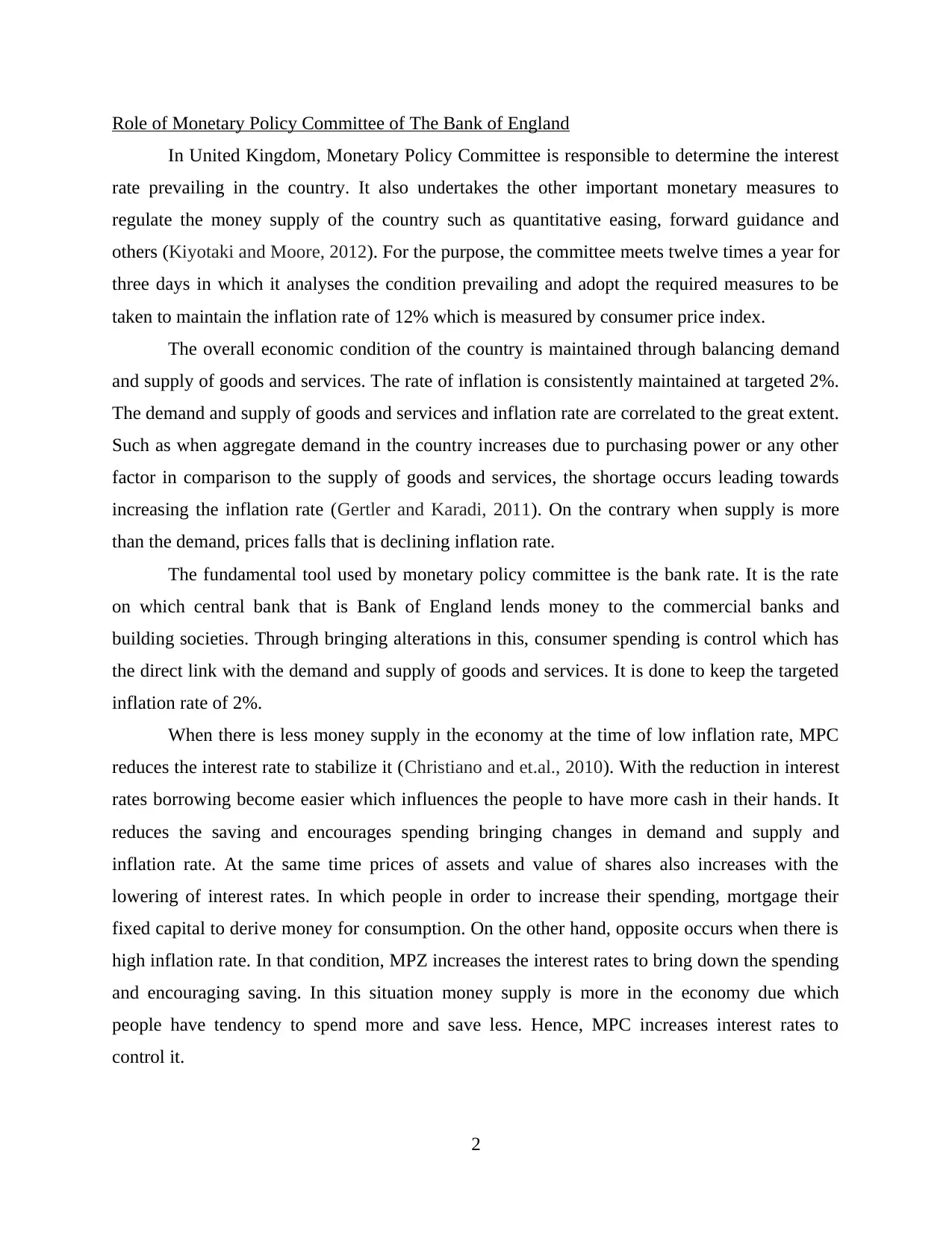
Role of Monetary Policy Committee of The Bank of England
In United Kingdom, Monetary Policy Committee is responsible to determine the interest
rate prevailing in the country. It also undertakes the other important monetary measures to
regulate the money supply of the country such as quantitative easing, forward guidance and
others (Kiyotaki and Moore, 2012). For the purpose, the committee meets twelve times a year for
three days in which it analyses the condition prevailing and adopt the required measures to be
taken to maintain the inflation rate of 12% which is measured by consumer price index.
The overall economic condition of the country is maintained through balancing demand
and supply of goods and services. The rate of inflation is consistently maintained at targeted 2%.
The demand and supply of goods and services and inflation rate are correlated to the great extent.
Such as when aggregate demand in the country increases due to purchasing power or any other
factor in comparison to the supply of goods and services, the shortage occurs leading towards
increasing the inflation rate (Gertler and Karadi, 2011). On the contrary when supply is more
than the demand, prices falls that is declining inflation rate.
The fundamental tool used by monetary policy committee is the bank rate. It is the rate
on which central bank that is Bank of England lends money to the commercial banks and
building societies. Through bringing alterations in this, consumer spending is control which has
the direct link with the demand and supply of goods and services. It is done to keep the targeted
inflation rate of 2%.
When there is less money supply in the economy at the time of low inflation rate, MPC
reduces the interest rate to stabilize it (Christiano and et.al., 2010). With the reduction in interest
rates borrowing become easier which influences the people to have more cash in their hands. It
reduces the saving and encourages spending bringing changes in demand and supply and
inflation rate. At the same time prices of assets and value of shares also increases with the
lowering of interest rates. In which people in order to increase their spending, mortgage their
fixed capital to derive money for consumption. On the other hand, opposite occurs when there is
high inflation rate. In that condition, MPZ increases the interest rates to bring down the spending
and encouraging saving. In this situation money supply is more in the economy due which
people have tendency to spend more and save less. Hence, MPC increases interest rates to
control it.
2
In United Kingdom, Monetary Policy Committee is responsible to determine the interest
rate prevailing in the country. It also undertakes the other important monetary measures to
regulate the money supply of the country such as quantitative easing, forward guidance and
others (Kiyotaki and Moore, 2012). For the purpose, the committee meets twelve times a year for
three days in which it analyses the condition prevailing and adopt the required measures to be
taken to maintain the inflation rate of 12% which is measured by consumer price index.
The overall economic condition of the country is maintained through balancing demand
and supply of goods and services. The rate of inflation is consistently maintained at targeted 2%.
The demand and supply of goods and services and inflation rate are correlated to the great extent.
Such as when aggregate demand in the country increases due to purchasing power or any other
factor in comparison to the supply of goods and services, the shortage occurs leading towards
increasing the inflation rate (Gertler and Karadi, 2011). On the contrary when supply is more
than the demand, prices falls that is declining inflation rate.
The fundamental tool used by monetary policy committee is the bank rate. It is the rate
on which central bank that is Bank of England lends money to the commercial banks and
building societies. Through bringing alterations in this, consumer spending is control which has
the direct link with the demand and supply of goods and services. It is done to keep the targeted
inflation rate of 2%.
When there is less money supply in the economy at the time of low inflation rate, MPC
reduces the interest rate to stabilize it (Christiano and et.al., 2010). With the reduction in interest
rates borrowing become easier which influences the people to have more cash in their hands. It
reduces the saving and encourages spending bringing changes in demand and supply and
inflation rate. At the same time prices of assets and value of shares also increases with the
lowering of interest rates. In which people in order to increase their spending, mortgage their
fixed capital to derive money for consumption. On the other hand, opposite occurs when there is
high inflation rate. In that condition, MPZ increases the interest rates to bring down the spending
and encouraging saving. In this situation money supply is more in the economy due which
people have tendency to spend more and save less. Hence, MPC increases interest rates to
control it.
2
Paraphrase This Document
Need a fresh take? Get an instant paraphrase of this document with our AI Paraphraser
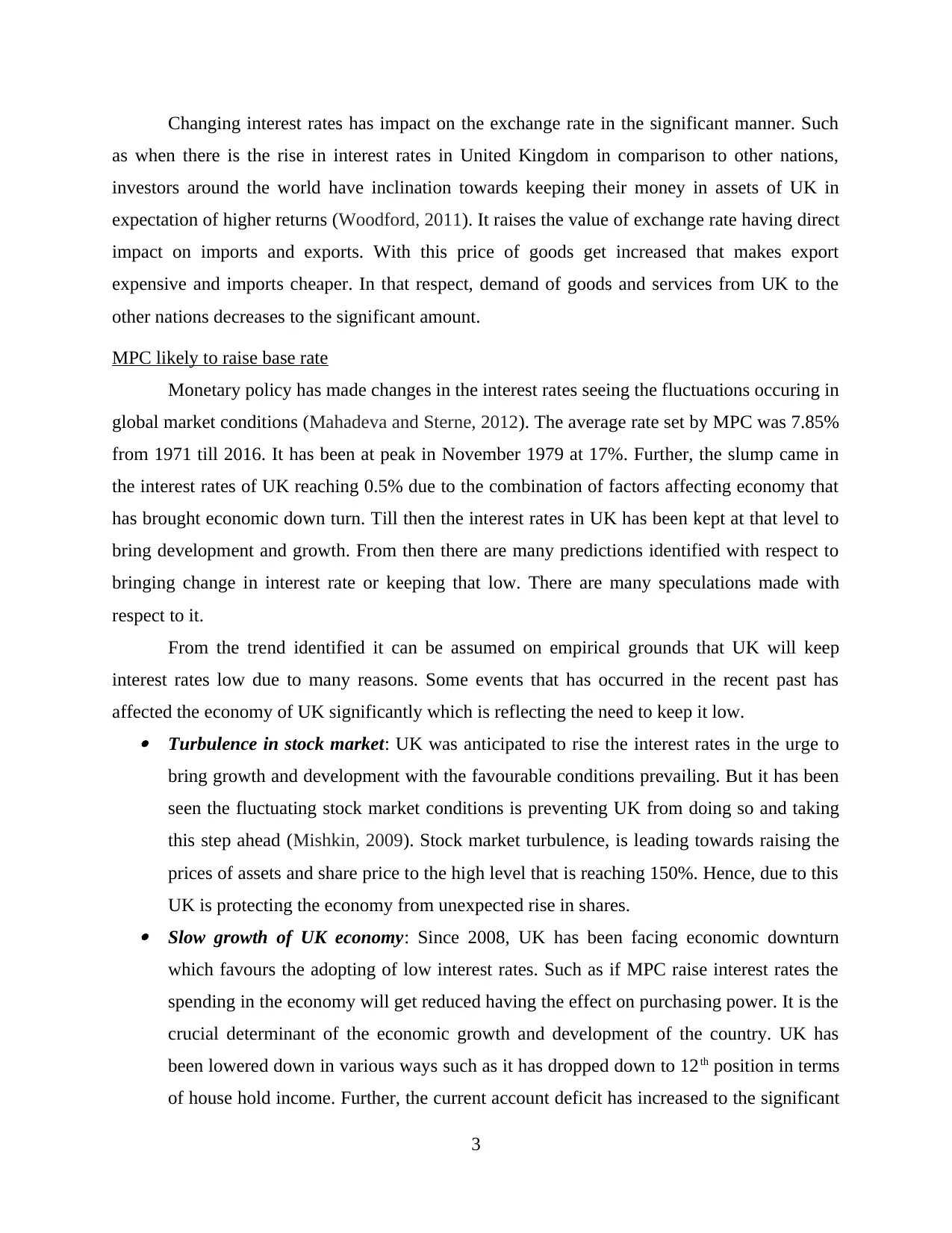
Changing interest rates has impact on the exchange rate in the significant manner. Such
as when there is the rise in interest rates in United Kingdom in comparison to other nations,
investors around the world have inclination towards keeping their money in assets of UK in
expectation of higher returns (Woodford, 2011). It raises the value of exchange rate having direct
impact on imports and exports. With this price of goods get increased that makes export
expensive and imports cheaper. In that respect, demand of goods and services from UK to the
other nations decreases to the significant amount.
MPC likely to raise base rate
Monetary policy has made changes in the interest rates seeing the fluctuations occuring in
global market conditions (Mahadeva and Sterne, 2012). The average rate set by MPC was 7.85%
from 1971 till 2016. It has been at peak in November 1979 at 17%. Further, the slump came in
the interest rates of UK reaching 0.5% due to the combination of factors affecting economy that
has brought economic down turn. Till then the interest rates in UK has been kept at that level to
bring development and growth. From then there are many predictions identified with respect to
bringing change in interest rate or keeping that low. There are many speculations made with
respect to it.
From the trend identified it can be assumed on empirical grounds that UK will keep
interest rates low due to many reasons. Some events that has occurred in the recent past has
affected the economy of UK significantly which is reflecting the need to keep it low. Turbulence in stock market: UK was anticipated to rise the interest rates in the urge to
bring growth and development with the favourable conditions prevailing. But it has been
seen the fluctuating stock market conditions is preventing UK from doing so and taking
this step ahead (Mishkin, 2009). Stock market turbulence, is leading towards raising the
prices of assets and share price to the high level that is reaching 150%. Hence, due to this
UK is protecting the economy from unexpected rise in shares. Slow growth of UK economy: Since 2008, UK has been facing economic downturn
which favours the adopting of low interest rates. Such as if MPC raise interest rates the
spending in the economy will get reduced having the effect on purchasing power. It is the
crucial determinant of the economic growth and development of the country. UK has
been lowered down in various ways such as it has dropped down to 12th position in terms
of house hold income. Further, the current account deficit has increased to the significant
3
as when there is the rise in interest rates in United Kingdom in comparison to other nations,
investors around the world have inclination towards keeping their money in assets of UK in
expectation of higher returns (Woodford, 2011). It raises the value of exchange rate having direct
impact on imports and exports. With this price of goods get increased that makes export
expensive and imports cheaper. In that respect, demand of goods and services from UK to the
other nations decreases to the significant amount.
MPC likely to raise base rate
Monetary policy has made changes in the interest rates seeing the fluctuations occuring in
global market conditions (Mahadeva and Sterne, 2012). The average rate set by MPC was 7.85%
from 1971 till 2016. It has been at peak in November 1979 at 17%. Further, the slump came in
the interest rates of UK reaching 0.5% due to the combination of factors affecting economy that
has brought economic down turn. Till then the interest rates in UK has been kept at that level to
bring development and growth. From then there are many predictions identified with respect to
bringing change in interest rate or keeping that low. There are many speculations made with
respect to it.
From the trend identified it can be assumed on empirical grounds that UK will keep
interest rates low due to many reasons. Some events that has occurred in the recent past has
affected the economy of UK significantly which is reflecting the need to keep it low. Turbulence in stock market: UK was anticipated to rise the interest rates in the urge to
bring growth and development with the favourable conditions prevailing. But it has been
seen the fluctuating stock market conditions is preventing UK from doing so and taking
this step ahead (Mishkin, 2009). Stock market turbulence, is leading towards raising the
prices of assets and share price to the high level that is reaching 150%. Hence, due to this
UK is protecting the economy from unexpected rise in shares. Slow growth of UK economy: Since 2008, UK has been facing economic downturn
which favours the adopting of low interest rates. Such as if MPC raise interest rates the
spending in the economy will get reduced having the effect on purchasing power. It is the
crucial determinant of the economic growth and development of the country. UK has
been lowered down in various ways such as it has dropped down to 12th position in terms
of house hold income. Further, the current account deficit has increased to the significant
3
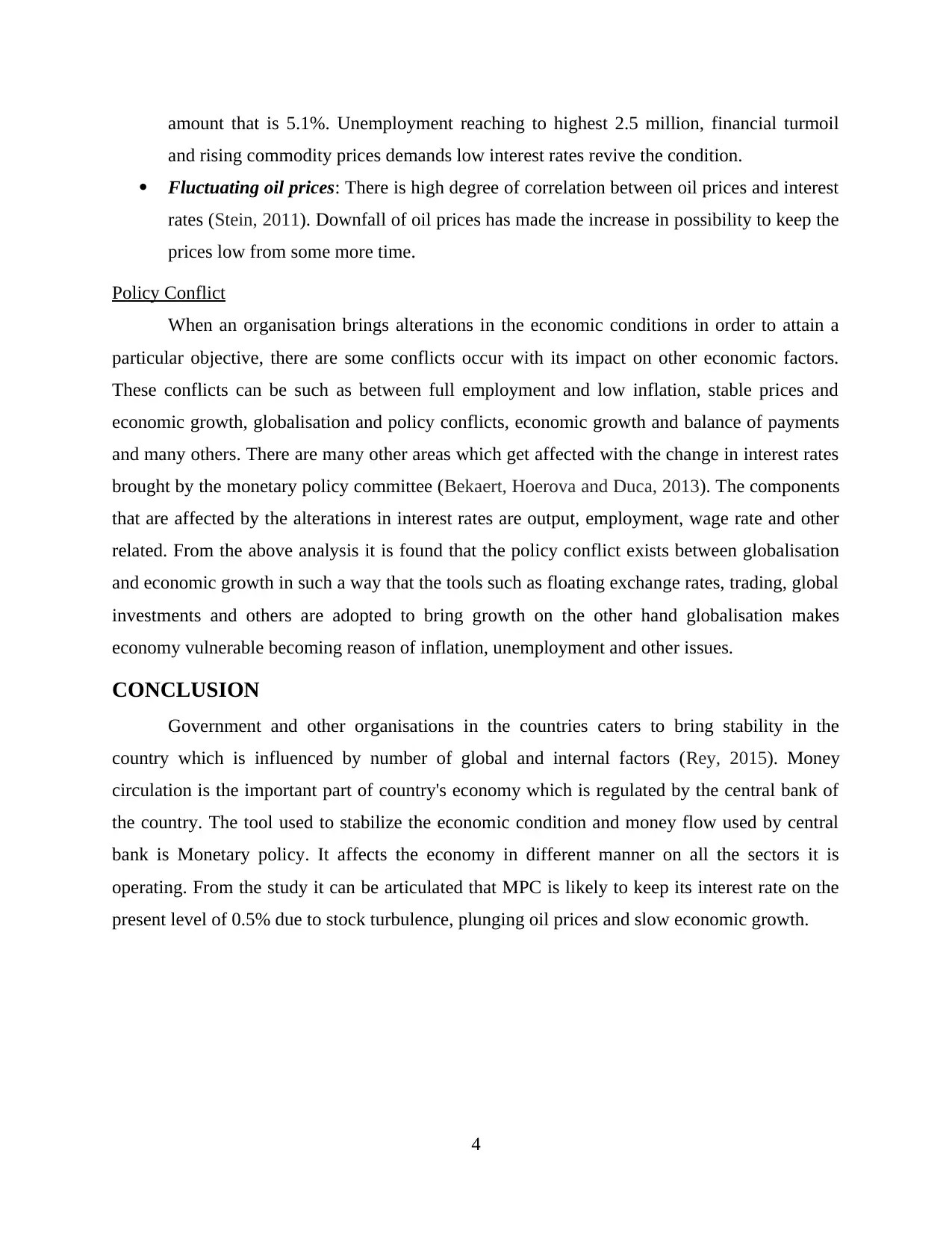
amount that is 5.1%. Unemployment reaching to highest 2.5 million, financial turmoil
and rising commodity prices demands low interest rates revive the condition.
Fluctuating oil prices: There is high degree of correlation between oil prices and interest
rates (Stein, 2011). Downfall of oil prices has made the increase in possibility to keep the
prices low from some more time.
Policy Conflict
When an organisation brings alterations in the economic conditions in order to attain a
particular objective, there are some conflicts occur with its impact on other economic factors.
These conflicts can be such as between full employment and low inflation, stable prices and
economic growth, globalisation and policy conflicts, economic growth and balance of payments
and many others. There are many other areas which get affected with the change in interest rates
brought by the monetary policy committee (Bekaert, Hoerova and Duca, 2013). The components
that are affected by the alterations in interest rates are output, employment, wage rate and other
related. From the above analysis it is found that the policy conflict exists between globalisation
and economic growth in such a way that the tools such as floating exchange rates, trading, global
investments and others are adopted to bring growth on the other hand globalisation makes
economy vulnerable becoming reason of inflation, unemployment and other issues.
CONCLUSION
Government and other organisations in the countries caters to bring stability in the
country which is influenced by number of global and internal factors (Rey, 2015). Money
circulation is the important part of country's economy which is regulated by the central bank of
the country. The tool used to stabilize the economic condition and money flow used by central
bank is Monetary policy. It affects the economy in different manner on all the sectors it is
operating. From the study it can be articulated that MPC is likely to keep its interest rate on the
present level of 0.5% due to stock turbulence, plunging oil prices and slow economic growth.
4
and rising commodity prices demands low interest rates revive the condition.
Fluctuating oil prices: There is high degree of correlation between oil prices and interest
rates (Stein, 2011). Downfall of oil prices has made the increase in possibility to keep the
prices low from some more time.
Policy Conflict
When an organisation brings alterations in the economic conditions in order to attain a
particular objective, there are some conflicts occur with its impact on other economic factors.
These conflicts can be such as between full employment and low inflation, stable prices and
economic growth, globalisation and policy conflicts, economic growth and balance of payments
and many others. There are many other areas which get affected with the change in interest rates
brought by the monetary policy committee (Bekaert, Hoerova and Duca, 2013). The components
that are affected by the alterations in interest rates are output, employment, wage rate and other
related. From the above analysis it is found that the policy conflict exists between globalisation
and economic growth in such a way that the tools such as floating exchange rates, trading, global
investments and others are adopted to bring growth on the other hand globalisation makes
economy vulnerable becoming reason of inflation, unemployment and other issues.
CONCLUSION
Government and other organisations in the countries caters to bring stability in the
country which is influenced by number of global and internal factors (Rey, 2015). Money
circulation is the important part of country's economy which is regulated by the central bank of
the country. The tool used to stabilize the economic condition and money flow used by central
bank is Monetary policy. It affects the economy in different manner on all the sectors it is
operating. From the study it can be articulated that MPC is likely to keep its interest rate on the
present level of 0.5% due to stock turbulence, plunging oil prices and slow economic growth.
4
⊘ This is a preview!⊘
Do you want full access?
Subscribe today to unlock all pages.

Trusted by 1+ million students worldwide
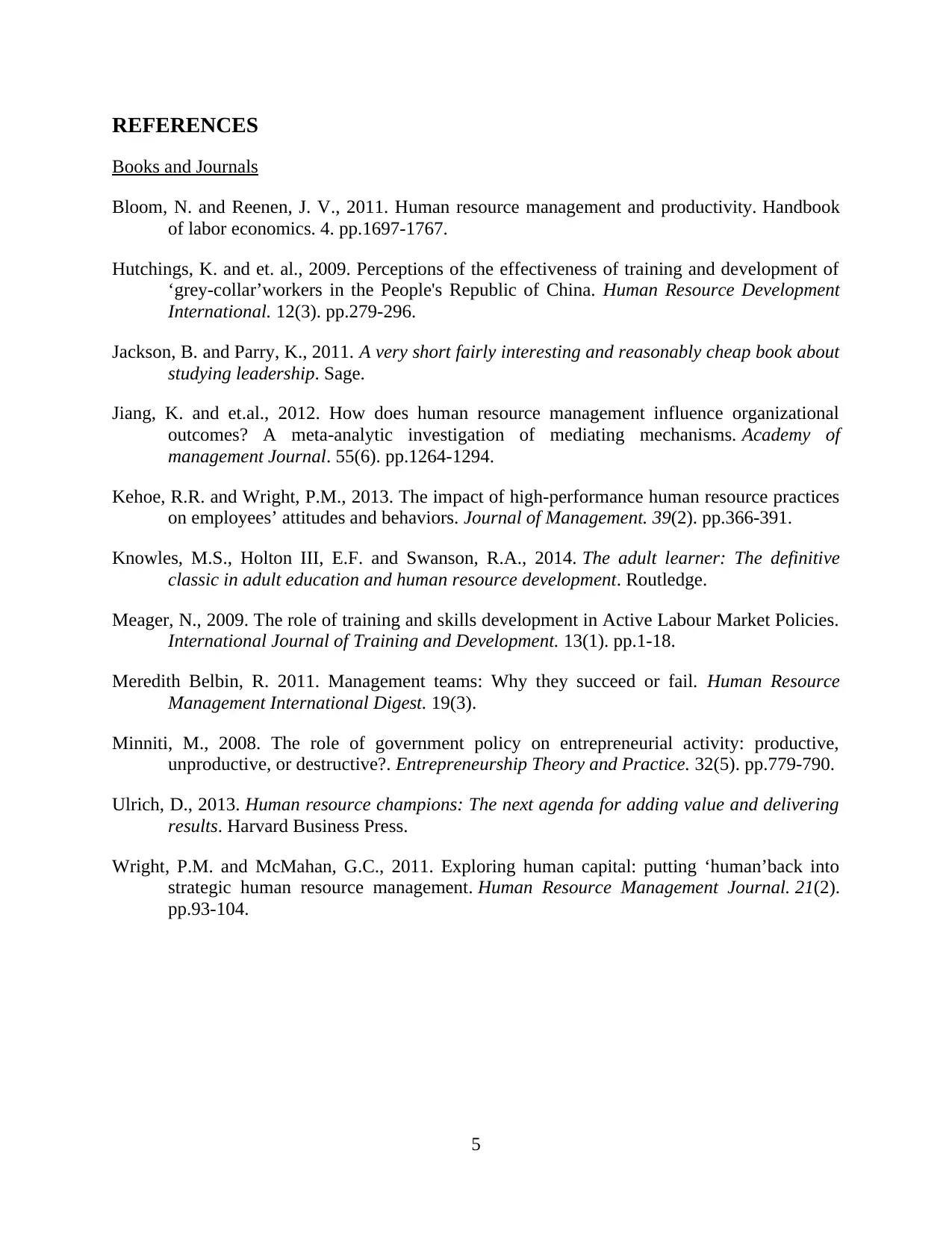
REFERENCES
Books and Journals
Bloom, N. and Reenen, J. V., 2011. Human resource management and productivity. Handbook
of labor economics. 4. pp.1697-1767.
Hutchings, K. and et. al., 2009. Perceptions of the effectiveness of training and development of
‘grey-collar’workers in the People's Republic of China. Human Resource Development
International. 12(3). pp.279-296.
Jackson, B. and Parry, K., 2011. A very short fairly interesting and reasonably cheap book about
studying leadership. Sage.
Jiang, K. and et.al., 2012. How does human resource management influence organizational
outcomes? A meta-analytic investigation of mediating mechanisms. Academy of
management Journal. 55(6). pp.1264-1294.
Kehoe, R.R. and Wright, P.M., 2013. The impact of high-performance human resource practices
on employees’ attitudes and behaviors. Journal of Management. 39(2). pp.366-391.
Knowles, M.S., Holton III, E.F. and Swanson, R.A., 2014. The adult learner: The definitive
classic in adult education and human resource development. Routledge.
Meager, N., 2009. The role of training and skills development in Active Labour Market Policies.
International Journal of Training and Development. 13(1). pp.1-18.
Meredith Belbin, R. 2011. Management teams: Why they succeed or fail. Human Resource
Management International Digest. 19(3).
Minniti, M., 2008. The role of government policy on entrepreneurial activity: productive,
unproductive, or destructive?. Entrepreneurship Theory and Practice. 32(5). pp.779-790.
Ulrich, D., 2013. Human resource champions: The next agenda for adding value and delivering
results. Harvard Business Press.
Wright, P.M. and McMahan, G.C., 2011. Exploring human capital: putting ‘human’back into
strategic human resource management. Human Resource Management Journal. 21(2).
pp.93-104.
5
Books and Journals
Bloom, N. and Reenen, J. V., 2011. Human resource management and productivity. Handbook
of labor economics. 4. pp.1697-1767.
Hutchings, K. and et. al., 2009. Perceptions of the effectiveness of training and development of
‘grey-collar’workers in the People's Republic of China. Human Resource Development
International. 12(3). pp.279-296.
Jackson, B. and Parry, K., 2011. A very short fairly interesting and reasonably cheap book about
studying leadership. Sage.
Jiang, K. and et.al., 2012. How does human resource management influence organizational
outcomes? A meta-analytic investigation of mediating mechanisms. Academy of
management Journal. 55(6). pp.1264-1294.
Kehoe, R.R. and Wright, P.M., 2013. The impact of high-performance human resource practices
on employees’ attitudes and behaviors. Journal of Management. 39(2). pp.366-391.
Knowles, M.S., Holton III, E.F. and Swanson, R.A., 2014. The adult learner: The definitive
classic in adult education and human resource development. Routledge.
Meager, N., 2009. The role of training and skills development in Active Labour Market Policies.
International Journal of Training and Development. 13(1). pp.1-18.
Meredith Belbin, R. 2011. Management teams: Why they succeed or fail. Human Resource
Management International Digest. 19(3).
Minniti, M., 2008. The role of government policy on entrepreneurial activity: productive,
unproductive, or destructive?. Entrepreneurship Theory and Practice. 32(5). pp.779-790.
Ulrich, D., 2013. Human resource champions: The next agenda for adding value and delivering
results. Harvard Business Press.
Wright, P.M. and McMahan, G.C., 2011. Exploring human capital: putting ‘human’back into
strategic human resource management. Human Resource Management Journal. 21(2).
pp.93-104.
5
1 out of 7
Related Documents
Your All-in-One AI-Powered Toolkit for Academic Success.
+13062052269
info@desklib.com
Available 24*7 on WhatsApp / Email
![[object Object]](/_next/static/media/star-bottom.7253800d.svg)
Unlock your academic potential
Copyright © 2020–2025 A2Z Services. All Rights Reserved. Developed and managed by ZUCOL.





